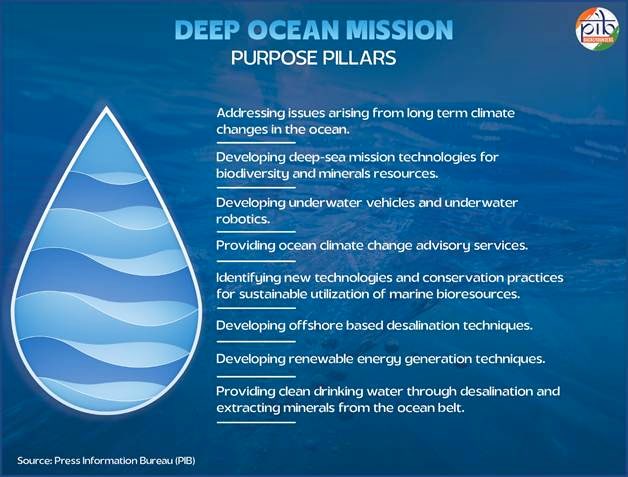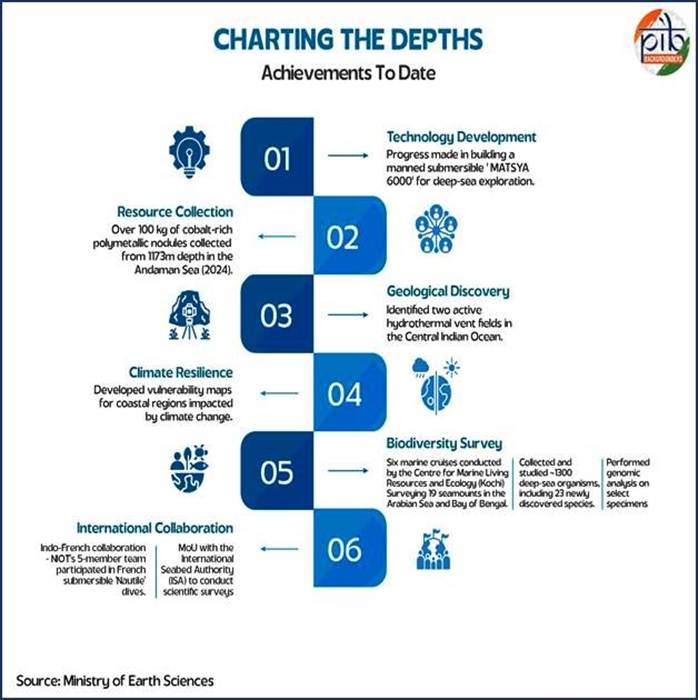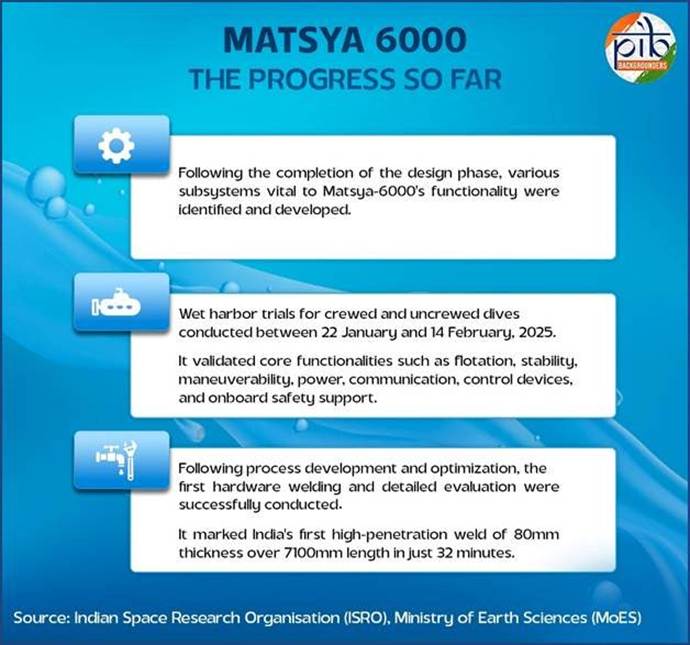Content
- DEEP OCEAN MISSION
- S&P Upgrades India’s Sovereign Rating to ‘BBB’
DEEP OCEAN MISSION

Context & Background
- Oceans & Human History: Oceans cover ~71% of Earth’s surface; yet >80% remains unexplored. They influence climate, biodiversity, energy, and economy.
- Why deep-sea exploration matters:
- Mineral wealth (polymetallic nodules: cobalt, nickel, manganese, copper).
- Biodiversity (microbes, flora, fauna with biotech/medical potential).
- Energy & freshwater (OTEC, gas hydrates, desalination).
- Blue Economy (World Bank, 2017): Sustainable use of ocean resources for economic growth, improved livelihoods, and ocean ecosystem health. India included it as a 10 core growth dimension in its Vision 2030.
- Global backdrop: UN Decade of Ocean Science (2021–30) pushes nations to explore oceans sustainably.
- India’s geography advantage: 11,098 km coastline, 1382 islands, EEZ (Exclusive Economic Zone) of ~2.37 million sq. km.
Relevance : GS 3(Science and Tech,Environment )
Deep Ocean Mission (Launched: Sept 2021, MoES)
- Budget: ₹4077 crore (5 years).
- Objective: Develop technologies for sustainable deep-ocean exploration and harnessing resources to power Blue Economy.
- National ambition: Position India among elite group (USA, Russia, France, Japan, China) with deep-sea manned submersible capability.
- Key event (Aug 2025): India’s aquanauts conducted first 5000 m deep dive, collecting 100+ kg cobalt-rich polymetallic nodules.
Mission Components (6 Pillars)
- Deep Sea Mining & Manned Submersible
- Development of MATSYA 6000 (HOV, 3 crew, depth: 6000 m, 12 hr op., 96 hr emergency).
- Extraction system for polymetallic nodules in Central Indian Ocean Basin (CIOB).
- Prepares India for future commercial mining (post-International Seabed Authority regulations).
- Ocean Climate Change Advisory Services
- Climate models from seasonal to decadal scale.
- Input for fisheries, coastal tourism, disaster resilience.
- Biodiversity & Bioprospecting
- Exploration of microbes, flora, fauna → applications in pharma, enzymes, nutraceuticals.
- Supports marine fisheries & allied services.
- Deep Ocean Survey & Exploration
- Identifying hydrothermal sulphide sites & mapping polymetallic nodules.
- Energy & Freshwater from Ocean
- Offshore OTEC-powered desalination plant (proof of concept).
- Advanced Marine Station for Ocean Biology
- R&D incubator: ocean biology + engineering → industrial spin-offs.

Project Samudrayaan (Flagship under DOM)
- MATSYA 6000:
- Design: Spherical titanium-alloy vessel, diameter 2260 mm, wall 80 mm, withstands 600 bar, temp -3°C.
- Safety systems: Li-Po batteries, acoustic telephones, emergency drop-weight, bio-vests, life-support redundancy.
- Made in India: Ti-alloy welding perfected by ISRO (LPSC), 700 trials. Tested by advanced NDE methods (TOFD, PAUT).

- Collaboration: NIOT (MoES) + VSSC (ISRO).
- Trials (2025): Dry & wet trials at L&T Shipyard, Chennai.
- International milestone: Indo-French expedition (Aug 2025) with IFREMER’s Nautile → 5000 m dive, training Indian aquanauts.

Technology & Validation
- Testing phases:
- 8 dives (5 unmanned, 3–5 manned) validating life-support, navigation, manipulator arms, communication.
- 2022: OMe 6000 AUV mapped PMN site (5271 m depth, 14 sq. km).
- Future roadmap:
- 2026: Shallow water demo (500 m).
- 2027: Deep-sea validation (6000 m).
- 2027–28: Full-fledged scientific exploration with MATSYA 6000.
Strategic Significance
- Economic: Potential $100+ billion Blue Economy sector for India.
- Strategic: Rare Earths, cobalt (critical for EV batteries, defense, AI electronics).
- Geopolitics: Counters China’s lead in deep-sea mining (Beijing holds 4 ISA contracts).
- Technology Sovereignty: Indigenous HOV places India in exclusive club (<6 nations).
- Employment & Innovation: Marine engineering, biotechnology, offshore energy, start-ups.
Challenges & Concerns
- Ecological:
- Deep-sea ecosystems fragile, recovery spans centuries.
- Mining disrupts biodiversity, carbon storage.
- Legal:
- Governed by UNCLOS + International Seabed Authority (ISA) (India holds 75,000 sq. km exploration block in CIOB).
- Need compliance with global seabed mining code (not finalized yet).
- Financial: High costs; uncertain commercial returns.
- Technological: Ensuring long-duration crew safety, reliable communication, power endurance.
- Social: Fisherfolk displacement if coastal projects expand unchecked.
India vs World
- USA/Russia/France: Advanced manned subs (e.g., Alvin, Nautile).
- China: Fendouzhe reached 10,909 m (Mariana Trench, 2020). Leads in polymetallic nodules exploration.
- Japan: JAMSTEC – Shinkai 6500.
- India: Catching up fast → success of Matsya 6000 will be a prestige multiplier, like Chandrayaan-3 in space.
Conclusion
- Strategic & Scientific Leap: DOM places India among the few nations mastering deep-sea technologies, enhancing sovereignty in critical minerals, marine research, and ocean engineering.
- Economic & Blue Economy Potential: It can unlock resources worth billions, drive innovation, and strengthen India’s Blue Economy pillars—fisheries, biotechnology, offshore energy, and marine industries.
- Sustainability Imperative: While promising prosperity, DOM must balance exploration with ecological safeguards under global norms, ensuring oceans remain a resilient resource for future generations.
S&P Upgrades India’s Sovereign Rating to ‘BBB’
Basics & Context
- What is a sovereign credit rating?
- An independent assessment of a country’s ability and willingness to meet debt obligations.
- Issued by rating agencies (S&P, Moody’s, Fitch).
- Impacts borrowing costs, FDI flows, and global investor perception.
- Who is S&P Global?
- Standard & Poor’s Global Ratings – among the “Big Three” agencies along with Moody’s and Fitch.
- Known for sovereign, corporate, and financial market ratings.
- Rating Scale (simplified):
- Investment grade: AAA, AA, A, BBB.
- Speculative (junk): BB, B, CCC, etc.
- India’s shift: BBB- (lowest investment grade, 2007) → BBB (2025).
- Short-term rating: A-3 → A-2 (stronger short-term repayment capacity).
- Significance of the 2025 Upgrade:
- First upgrade in 18 years.
- Reflects stronger fundamentals post-pandemic.
- Aligns with India’s ambition to be a top-3 global economy by 2030.
Relevance: GS 3(Indian Economy)
Why the Upgrade Happened
- Strong GDP Growth:
- Post-pandemic rebound → avg. 8.8% (FY22–FY24).
- Projection: 6.8% annually next 3 years (fastest in Asia-Pacific).
- Fiscal Discipline:
- Centre’s deficit: 4.8% (FY25), target 4.4% (FY26).
- General govt. deficit: expected fall from 7.3% (FY26) → 6.6% (FY29).
- Infrastructure push (~5.5% of GDP) funded without widening CAD.
- Monetary Stability:
- Inflation kept within RBI’s 2–6% band since 2015.
- CPI avg. 5.5% (3 yrs), but dropped to 1.6% (July 2025).
- Repo rate eased to 5.5% (Feb–July 2025).
- External Stability:
- Modest net external asset position.
- CAD small, weaker rupee improving export competitiveness.
Fiscal & Debt Dynamics
- Debt Profile:
- Pandemic spike: +9–13% of GDP debt increase.
- Now reduced to +7.8% net debt/GDP.
- Capex Strategy:
- Union govt. capex: ₹11.2 trillion (3.1% of GDP, FY26).
- Public investment (centre + states): ~5.5% of GDP.
- Focus: infra, logistics, energy transition.
- Quality of Spending:
- Shift from subsidies to capital formation.
- Credibility reinforced as deficits fall while infra rises.
Economic & Financial Implications
- Lower Borrowing Costs:
- Sovereign bonds → cheaper global loans.
- Spillover → lower corporate & bank borrowing costs.
- Investor Confidence:
- Higher FPI/FII inflows into debt & equity.
- Lower country risk premium → India more attractive vs EM peers.
- Multiplier Effect:
- Capital inflows → rupee stability.
- Stronger balance of payments → forex reserves rise.
- More funds for infra & job creation.
Global Context & Comparisons
- India’s position: BBB is still lowest rung of mid-tier investment grade.
- Peers:
- Higher-rated: China (A+), Korea (AA), Singapore (AAA).
- Similar: Indonesia (BBB), Philippines (BBB+).
- Implication: India has broken stagnation, but still needs reforms to climb higher.
Risks & Challenges
- Debt Burden: Public debt ~83–85% of GDP (high vs peers).
- Banking/NPAs: Though reduced, PSU banks’ health remains uneven.
- Employment Generation: Growth needs to translate into jobs; rating agencies wary if jobless growth persists.
- Global Headwinds: Oil shocks, US Fed policy tightening, geopolitical risks (Red Sea, Russia-Ukraine, China-Taiwan).
- Inflation Risks: Currently low, but commodity cycles could reverse.
- Structural Bottlenecks: Land, labour, judicial delays, infra project execution.
Conclusion
- Validation of Reforms: The upgrade reflects India’s resilient growth, prudent fiscal consolidation, and inflation stability, marking global recognition of its policy credibility.
- Catalyst for Investment: Improved rating lowers borrowing costs and boosts investor confidence, enabling capital inflows for infrastructure and job creation.
- Way Forward: Sustaining this momentum requires deeper structural reforms, managing debt prudently, and ensuring growth translates into inclusive development.



